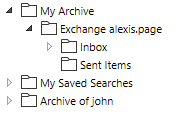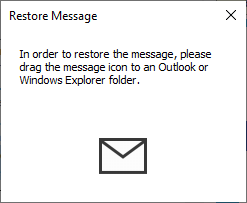Accessing the Archive with the Microsoft Outlook integration
MailStore users can access their archives using a convenient add-in for Microsoft Outlook. A list of supported Microsoft Outlook versions can be found under System Requirements.
Requirements
MailStore Server should be in use and the add-in for Microsoft Outlook should be installed on the appropriate machine. In this case, a toolbar (up to 2007) or a tab (Outook 2010 or later) labeled "MailStore" will be visible in Microsoft Outlook.
Image: MailStore toolbar in Microsoft Outlook 2007
Image: MailStore tab in Microsoft Outlook 2010
Image: MailStore tab in Microsoft Outlook 2013
Login to MailStore Server
If the MailStore Outlook Add-in is not pre-configured, you will be asked to log in to MailStore Server as soon as you click any button in the MailStore Outlook Add-in. Please refer to your system administrator for the server name and your access data.
Deleting Saved Access Data
If you would like to log in to a different server or use different access data, you may have to delete the existing access information saved in Microsoft Outlook. Please proceed as follows:
- Click on Settings in the MailStore Outlook Add-in
- Click on Clear Cached Credentials.
- Click on OK.
- Click on any button in the add-in to go back to the login window.
Technical Considerations
- The MailStore Outlook Add-in uses the HTTP server integrated in MailStore Server to access the archive.
- If a valid SSL certificate was selected within the MailStore Server Service Configuration, you can mark the checkbox Secure Connection in the Outlook Add-in settings to use HTTPS instead of HTTP.
- If you have changed the configuration of the HTTP/HTTPS ports within the MailStore Server Service Configuration (the default HTTP port is 8461, the default HTTPS port is 8462), you must include the port number when logging in. Simply append the port number to the server name, separated by a colon (for example:
mailstore:443)
Search by Archive Folder
Display of the Archive Folder
In the MailStore Outlook Add-in, click on Browse Archive to display the part of the archive that is visible to you.
User Archives
The folder My Archive contains all emails that were archived from your mailboxes. If you have read-access to the archives of additional users, their emails are located in the folders labeled Archive of <user name>.
Display of Emails in a Folder
To view the emails of a specific folder, simply click on the folder name. The emails are listed below the tree structure.
Quick Search
With quick search you can browse all emails located in the archives you have access to. This feature is especially suitable for simple queries; alternatively, the extended search can be used (see below).
Using Quick Search
The input field is located in the MailStore Outlook Add-in. Simply enter one or more keywords and press ENTER. The search results are displayed. Keywords which appear in the header or the subject line are highlighted.
Searching for Word Fragments
To display all emails containing a word beginning with a particular fragment, use the wildcard character (*). For example:
auto*
will return auto, automatic, automobile etc.
Searching for Words with unknown letters
To view all emails containing a word where you do not know how to spell it correctly, you can use the question mark (?). For example
"ho?se"
would locate house and horse.
Searching for Phrases
To search for words appearing consecutively and in a specific order, use quotation marks (""). For example:
"Microsoft Windows"
will return the text Microsoft Windows but not Microsoft Works or Windows 95.
Narrowing by Fields
A search for keywords or phrases can be limited to specific fields. For example:
subject:News only in Subject from:[email protected] only in From to:[email protected] only in To cc:[email protected] only in Cc bcc:[email protected] only in Bcc
Excluding Words
To narrow a search, you may want to specify words which must not be present in the emails. To exclude words from the search results, prepend the word with the minus character (-). For example:
ZDNet -download-tip
returns all emails from ZDNet which do not contain download-tip.
Combining Search Options
Any of the search options described above can be combined. For example:
ZDNET -"Daily Update"
returns all emails from ZDNet which do not contain the consecutive words Daily Update.
Advanced Search
With MailStore's integrated extended search, complex queries can be executed which may not only refer to the email content but also parameters such as the date or the email size.
Using the Advanced Search
In the MailStore Outlook Add-in, click on Advanced Search and enter the search parameters. The criteria are AND-connected, i.e. the search returns only those emails satisfying all criteria. Click on Search to start the search.
Search Criteria under "Extended Search"
Enter a keyword or phrase into the text field, and specify where MailStore is to direct the search.The following options are available:
- Subject - The subject line of the email is searched.
- Sender/Recipient - The fields "From", "To", "Cc", and "Bcc" are searched.
- Message body - The text-only or HTML sections of the email are searched (depending on availability).
- Attachments File Names - The file names of the email attachments are searched.
- Attachment Contents - The contents of the email attachments are searched. If and to what extent attachments can be searched depends on the indexing options specified (under Administrative Tools).
In the textfield Search for, all options described in section Quick Search, such as phrases and wildcards, are available here as well.
Search Criteria under "General"
Under General, the following options are available:
- Folder - The folder to be searched by MailStore can be selected here. By default, this is the main folder of the current user. By clicking the button to the right of the text field, folders can also be selected using the folder structure. As administrator, the folders of all users can be searched.
- Include subfolder - If selected, MailStore not only searches the selected folder (e.g. Inbox), but all subfolders created therein (e.g. Inbox / Projects 2008 / Profit Optimization) as well.
- From - Any keywords or email addresses entered here are searched for only within the email's sender field.
- To/Cc/Bcc - Any keywords or email addresses entered here are searched for only within the email's recipient fields.
- Date - The timeframe the search is to cover can be selected here. Either a predefined range, such as Yesterday or This year, can be selected or, by choosing Custom, a specific period can be specified manually. In this case, the start and end dates will be included.
In the fields From and To/Cc/Bcc, all options, such as phrases and wildcards, described in section Quick Search are available.
Search Criteria under "Extended"
Under Advanced, the following options are available:
- Messages with/without attachments - By default, all messages are searched, regardless of whether or not they have any file attachments. Clear one of the check boxes to remove certain emails, such as those without attachments, from the results.
- Important: These searches can be imprecise at times because items like background pictures could be regarded as attachments.
- Size - By default, all messages are searched regardless of their size. Use the appropriate fields provided to limit the search according to the size of the emails, e.g. at least 5 MB or between 400 and 600 KB.
- Priority - Emails are searched according to the priority level of the email as assigned by the sender. When choosing Low, all emails with a priority level lower than Normal are returned, when choosing High, all emails with a priority level higher than Normal are returned. Emails not containing any information regarding priority are assumed to have a priority level of Normal.
Starting a Search
Click on Search to start the search. The results are displayed in a list.
Refining the Search Results
To narrow the results after a search has been executed, click on Advanced Search again, enter additional search criteria and click on Search.
Starting a New Search
To start a new search, click on New Query. All search criteria will be reset to their default values (i.e. no restrictions; the search covers all folders of the current user).
Saving a Search
Search criteria that are used repeatedly (such as "all receipts from the last month") can be saved and reused at any time. Click on Save As... and choose a meaningful name for the search. Click on Open to access, edit or restart the search.
Email Display
To view an email which was returned by one of the search functions described above, simply click on it. A preview of the email is displayed on the right side of the screen.
Please keep in mind that images and any formatting will not be displayed in the preview for security reasons. Emails cannot be forwarded or replied to within the preview, either.
For a comprehensive view of an archived email and the ability to use all the Microsoft Outlook features such as printing, forwarding and replying, click on Open Email in the MailStore Outlook Add-in. The email will be loaded from the archive and displayed, either immediately or after a few seconds depending on size.
Restoring Emails to the Application
To restore an archived email which is no longer in your mailbox to Outlook, please proceed as follows:
- Locate the email within the archive and open it.
- In the MailStore Outlook Add-in, click on Restore Message.
- Drag and drop the envelope icon into an Outlook email folder or a Windows Explorer file system folder.
- The email is restored immediately or after a few seconds, depending on its size.
Changing Regional Settings
By default the MailStore Outlook Add-in uses the same regional settings as Microsoft Outlook. The regional settings can also be set manually in the MailStore Outlook Add-in settings dialog.







